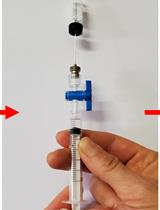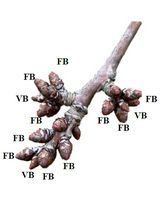- EN - English
- CN - 中文
Bi-directional Dual-flow-RootChip for Physiological Analysis of Plant Primary Roots Under Asymmetric Perfusion of Stress Treatments
双向双流式根芯片在不对称胁迫处理下对植物主根的生理分析
发布: 2023年08月05日第13卷第15期 DOI: 10.21769/BioProtoc.4764 浏览次数: 1558
评审: Anonymous reviewer(s)

相关实验方案

使用气相色谱和火焰离子化检测技术对亚热带乔木作物荔枝(Litchi chinensis Sonn.)叶和芽组织中乙烯产量进行定量分析
Regina B. Cronje and Arnoldus J. Jonker
2023年03月20日 1339 阅读
Abstract
Due to technical limitations, research to date has mainly focused on the role of abiotic and biotic stress–signalling molecules in the aerial organs of plants, including the whole shoot, stem, and leaves. Novel experimental platforms including the dual-flow-RootChip (dfRC), PlantChip, and RootArray have since expanded this to plant-root cell analysis. Based on microfluidic platforms for flow stream shaping and force sensing on tip-growing organisms, the dfRC has further been expanded into a bi-directional dual‐flow‐RootChip (bi-dfRC), incorporating a second adjacent pair of inlets/outlet, enabling bi-directional asymmetric perfusion of treatments towards plant roots (shoot-to-root or root-to-shoot). This protocol outlines, in detail, the design and use of the bi-dfRC platform. Plant culture on chip is combined with guided root growth and controlled exposure of the primary root to solute changes. The impact of surface treatment on root growth and defence signals can be tracked in response to abiotic and biotic stress or the combinatory effect of both. In particular, this protocol highlights the ability of the platform to culture a variety of plants, such as Arabidopsis thaliana, Nicotiana benthamiana, and Solanum lycopersicum, on chip. It demonstrates that by simply altering the dimensions of the bi-dfRC, a broad application basis to study desired plant species with varying primary root sizes under microfluidics is achieved.
Key features
• Expansion of the method developed by Stanley et al. (2018a) to study the directionality of defence signals responding to localised treatments.
Description of a microfluidic platform allowing culture of plants with primary roots up to 40 mm length, 550 μm width, and 500 μm height.
Treatment with polyvinylpyrrolidone (PVP) to permanently retain the hydrophilicity of partially hydrophobic bi-dfRC microchannels, enabling use with surface-sensitive plant lines.
• Description of novel tubing array setup equipped with rotatable valves for switching treatment reagent and orientation, while live-imaging on the bi-dfRC.
Graphical overview

Graphical overview of bi-dfRC fabrication, plantlet culture, and setup for root physiological analysis. (a) Schematic diagram depicting photolithography and replica molding, to produce a PDMS device. (b) Schematic diagram depicting seed culture off chip, followed by sub-culture of 4-day-old plantlets on chip. (c) Schematic diagram depicting microscopy and imaging setup, equipped with a media delivery system for asymmetric treatment introduction into the bi-dfRC microchannel root physiological analysis under varying conditions.
Background
Plant survival in abiotic and biotic stress conditions is linked with the ability to respond to the external environment through signal transduction (Lamers et al., 2020). Data supports that drought and pathogen infection are two environmental stressors with an unequivocal impact on worldwide crop, forestry, and ecosystem loss (Farooq et al., 2012; Nazarov et al., 2020). Despite the severe impact, our knowledge on how abiotic and biotic stress impact plant defence is limited. Plant growth, development, and adaptation are the outcome of a signalling process within the plant (Nejat and Mantri, 2017). Calcium is a universal signal known to modulate gene expression, hormone release, movement (e.g., muscles, stomata), and cell death (Noman et al., 2021), amongst other processes. Recent research has shown that calcium interacts with reactive oxygen species signalling, specifically hydrogen peroxide, during abiotic and biotic stress (Sewelam et al., 2016; Toyota et al., 2018). Additionally, interplay exists with downstream signals including nitric oxide and phytohormones (Freschi, 2013). However, it remains unclear how these signalling processes interact to regulate root growth and adaptation towards environmental stress. Based on a microfluidic platform for flow stream shaping on tip-growing organisms (Stanley et al., 2018a and 2018b), a refined and enhanced bi-directional dual‐flow‐RootChip (bi-dfRC) platform was established (Allan et al., 2022 and 2023). The bi-dfRC incorporates a second adjacent set of microchannel inlets/outlets connected to the base of the root observation channel for flow reversal. By combining plant culture on chip, root extension and directionality of cellular signalling responses towards local stress conditions can be tracked via controlled exposure of the root to solute changes, in a variety of combinations and spatial orientations. This protocol highlights the broad culture capabilities of the bi-dfRC towards multiple plant species including Arabidopsis thaliana, Nicotiana benthamiana, and Solanum lycopersicum. On chip root culture can also accommodate touch-sensitive transgenic plant lines through hydrophobic retention of PVP-treated microchannels. By simply altering the microchannel dimensions, the culture of plantlet primary roots up to 40 mm × 550 µm× 500 μm (length, width, height) into the bi-dfRC becomes possible, highlighting the flexibility of the platform. These measurements are the largest of interest to date; however, the technology is available to adapt and manufacture even larger devices, given compatibility with desired imaging setups. For sizeable devices that become impractical for photolithography master mold fabrication, millifluidics may be utilised via 3D printing (Kitson et al., 2012). The knowledge delivered by microfluidic technology provides insight into plant signal transduction and facilitates a platform for future research on root and plant stress perception. This may lead to novel insight towards physiological processes for improved plant tolerance towards both abiotic stress events and pathogens.
Materials and reagents
Biological materials
Arabidopsis thaliana Columbia-0 (Col-0) wild-type seeds (in-house propagated)
Nicotiana benthamiana seeds (in-house propagated)
Solanum lycopersicum Money Maker seeds (Bunnings, Country Value, catalog number: 2961272)
Reagents
Negative-tone photoresist (DJMicrolaminates, Suex, catalog number: SUEX 100)
Photoresist developer (Microchemicals, catalog number: AZ326-MIF)
Chromium etchant solution (Sigma-Aldrich, catalog number: 651826)
Propylene glycol methyl ether acetate developer (Sigma-Aldrich, catalog number: 484431)
Isopropanol (Sigma-Aldrich, catalog number: I9516)
Acetone (Sigma-Aldrich, catalog number: 90872)
Methanol (Sigma-Aldrich, catalog number: 34860)
Anti-adhesion agent Trichloro (1H,1H,2H,2H-perfluorooctyl) silane (Sigma-Aldrich, catalog number: 48931)
Polydimethylsiloxane pre-polymer silicone elastomer base and silicone elastomer curing agent (Sigma-Aldrich, Sylgard 184, Electropar, catalog number: 761028-5EA)
Deionized water (Lab made)
Sudan blue dye (Sigma-Aldrich, catalog number: 306436)
Toluene (Sigma-Aldrich, catalog number: 244511)
Norland Optical Adhesive (AusOptic, Norland Products, catalog number: NOA-72)
Triton X-100 (Sigma-Aldrich, catalog number: X100)
Ethanol (70%) (Sigma-Aldrich, catalog number: 1.00986)
Polyvinylpyrrolidone (Kollidon) (Sigma-Aldrich, catalog number: 02286)
Murashige and Skoog medium (Duchefa, catalog number: MFCD00240976)
Plant agar (GoldBio, catalog number: P1001.0100)
2-ethanesulfonic acid (MES) (Sigma-Aldrich, catalog number: M3671)
Janola Liquid Bleach (40%) (OfficeMax, catalog number: 2233630)
Potassium hydroxide (10 M) (Sigma-Aldrich, catalog number: 06103).
Solutions
Polyvinylpyrrolidone (22% w/v) (see Recipes)
Half-strength (½) Murashige and Skoog medium with 3.1 mM MES liquid medium (see Recipes)
Plant agarose (see Recipes)
Half-strength (½) Murashige and Skoog with 0.31 mM MES plant agarose (see Recipes)
Recipes
Polyvinylpyrrolidone (22% w/v)
Reagent Final concentration Amount Kollidon 22% 2.22 g Deionized water n/a 10 mL Total 22% 10 mL Half-strength (½) Murashige and Skoog medium with 3.1 mM MES liquid medium
Reagent Final concentration Amount Murashige and Skoog ½ 6.084 g MES 3.1 mM 3.026 g Water (ultrapure) n/a 500 mL Total 10× 500 mL *Adjust pH to 5.6 using 10 M potassium hydroxide. For a 1× working concentration, dilute 1:10 ½ Murashige and Skoog with 3.1 mM MES in water (ultrapure). Autoclave at 121 °C for 1 h.
Plant agarose (1%)
Reagent Final concentration Amount Plant agar 1% 5 g Water (ultrapure) n/a 500 mL Total 1% 500 mL *Autoclave at 121 °C for 1 h.
Half-strength (½) Murashige and Skoog with 0.31 mM MES plant agarose
Reagent Final concentration Amount Murashige and Skoog ½ 100 mL MES 3.1 mM 100 mL Water (ultrapure) n/a 300 mL Plant agar 1% 500 mL Total 1× 500 mL *Add liquid media to pre-cooled molten plant agar and mix well.
Laboratory supplies
Photo-masks (Nanofilm, catalog number: 4 × 4 × 0.060 SL LRC 10M 1518 5K)
Single-side polished silicon wafers 4" (Prime grade, WaferPro, catalog number: J204001)
Polyethylene sheets (OfficeMax, Overhead Projector Transparency Film A4, catalog number: 1219839)
Poly (methyl methacrylate) ring (lab-made cast acrylic, Mulford Plastics)
100 mm × 100 mm × 3 mm thick steel slab (Lab made, Nzsteel)
26 mm × 60 mm glass microscope slides (Lab Supply, catalog number: MAR0101030)
Vacuum-sealable food storage bags (Noel Leeming, Sunbeam, catalog number: VS0520)
Seed raising soil mix (Mitre 10, Tui, catalog number: TSEE1533)
Vermiculite (Mitre 10, Garden Highlights, catalog number: GHVER05)
A4 and A3 paper (OfficeMax, catalog numbers: 2220938 and 2220350, respectively)
Photolithography mask aligner filter PL-360LP (Omega Filters, catalog number: W2927)
Plastic incubation chambers (Thermo Fisher Scientific, NuncTMOmniTrayTMSingle-Well Plate, catalog number: 242811)
Scalpel with No. 10 blade (OfficeMax, Swann Morton, catalog number: 2208318)
Hole punch Ø 1 mm, 3 mm, 5 mm (ProSciTech, catalog numbers: T983-10, T983-30, and T983-50, respectively)
10 mL glass test tube (Sigma-Aldrich, catalog number: CLS9944513)
Dome propagator (Mitre 10, Otaki Hydroponics, catalog number: TG3104013)
7.5 cm × 10 cm, 750 mL, and 15 L plastic growth pots (Mitre 10, IP Plastics, catalog numbers: 169840, 283255, and 283269, respectively)
Plastic seed collection base equipped with plastic sheath (Arasystem, catalog number: ASN002, Aracons 720)
90 mm round Petri dish (Thermo Fisher Scientific, catalog number: 101VR20)
8 cm metal sieve (Stevens, Capital Kitchen, catalog number: 6546448)
Toothpicks (Discount Office, Gilmours, catalog number: GL1010819)
1.5 mL microcentrifuge tube (Thermo Fisher Scientific, Eppendorf, catalog number: 0030125150)
Sealing film (Sigma-Aldrich, Parafilm, catalog number: HS234526C-1EA)
5 mL syringe (Amtech, catalog number: 302135)
Ethylene tetrafluoroethylene tubing OD 1/16" (Kinesis, catalog number: 1517L)
Platinum-cured silicon tubing (Darwin Microfluidics, catalog number: SHE-TUB-SIL-1*1)
Stainless steel 90° bent polydimethylsiloxane couplers (Lab made, Darwin Microfluidics, catalog number: PN-BEN-18G-20)
Flangeless fittings (¼-28, Kinesis, catalog number: XP-235x)
Quick Connect Luer adapters (Scientificlabs, Kinesis, catalog number: P-628)
4× 200 mm × 20 mm × 20 mm Aluminium V slot extrusion (Aluminium Extrusion Company)
4× 300 mm × 20 mm × 20 mm Aluminium V slot extrusion (Aluminium Extrusion Company)
4× 20 series Corner Bracket 3 way (Aluminium Extrusion Company)
1× 200 mm × 200 mm Poly (methyl methacrylate) sheet (Lab made, Sigma-Aldrich, catalog number: GF53167608)
4× 1 mm Aluminium L brackets (Lab made; Aluminium Extrusion Company)
20× 20 series T Slot Spring Nuts - M4 (Aluminium Extrusion Company)
Low Pressure Unions (Kinesis, catalog number: P-702)
High-performance liquid chromatography 4-way manual switching valves (Kinesis, catalog number: V-100D)
Equipment
Laser mask writer Heidelberg μPG101 (Heidelberg Instruments)
Convection oven (Thermo Fisher Scientific, Heratherm, catalog number: 51028112)
Oxygen plasma cleaner (Tergeo, PIE Scientific)
Sky-335R6 laminator (SkyDSB)
MA-6 Mask aligner (SUSS MicroTec)
Hot plate (Torrey Pines Scientific, catalog number: HS40)
Desiccator (Sp bel-art, catalog number: F42020-0000)
Vacuum pump (VABS Ltd, catalog number: TC-2000VS)
Fumigation hood (Thermoplastic Engineering, Xtracare VSS)
S2000 ultraviolet curing system (Polydispensing, OmniCure®)
Pressurised nitrogen gun (Vacuum, BLOVAC)
Guillotine/LC slicer (Lucy Clay, catalog number: V5)
Ultra sonication bath (Lab Supply, catalog number: ELM1005507)
Vacuum sealer (Harvey Norman, Foodsaver, catalog number: VS4500)
Growth chambers (Aralab, Fitoclima, catalog number: 600)
Laminar flow hood (LaboGene, ScanLaf)
Programmable Syringe Pump PHD2000 70-2001 (Darwin-microfluidics, Harvard Apparatus, catalog number: HA-70-3007)
Epifluorescence microscope (Zeiss, catalog number: AX10)
Software
L-Edit IC Mentor Graphics Siemens EDA (v2020.1, July 2020)
Fiji, ImageJ (2.9.0, September 2022)
ZEN 2 Blue Zeiss (v3.0, October 2022)
Procedure
文章信息
版权信息
© 2023 The Author(s); This is an open access article under the CC BY-NC license (https://creativecommons.org/licenses/by-nc/4.0/).
如何引用
Allan, C., Elliot, B., Nock, V. and Meisrimler, C. N. (2023). Bi-directional Dual-flow-RootChip for Physiological Analysis of Plant Primary Roots Under Asymmetric Perfusion of Stress Treatments. Bio-protocol 13(15): e4764. DOI: 10.21769/BioProtoc.4764.
分类
植物科学 > 植物生理学 > 植物生长
细胞生物学 > 细胞成像 > 微流体
生物科学 > 生物技术
您对这篇实验方法有问题吗?
在此处发布您的问题,我们将邀请本文作者来回答。同时,我们会将您的问题发布到Bio-protocol Exchange,以便寻求社区成员的帮助。
提问指南
+ 问题描述
写下详细的问题描述,包括所有有助于他人回答您问题的信息(例如实验过程、条件和相关图像等)。
Share
Bluesky
X
Copy link










